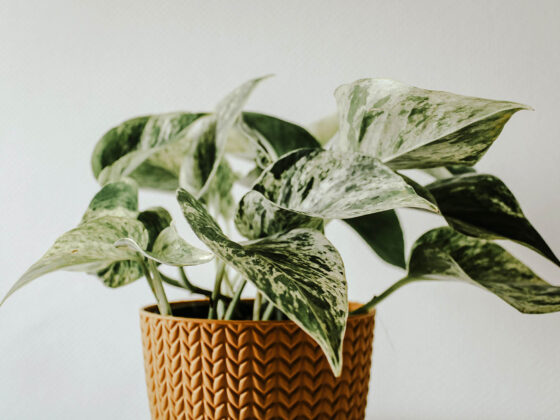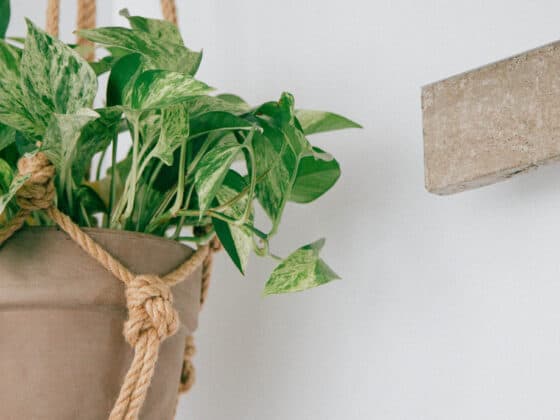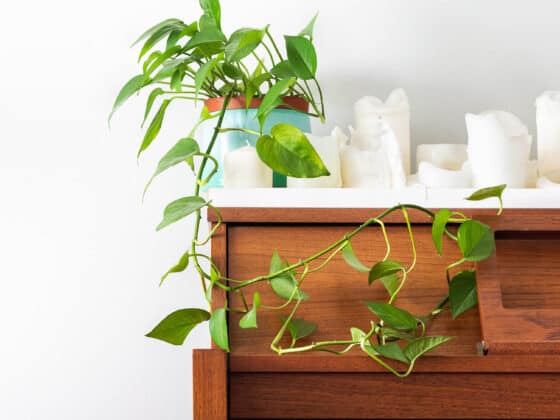The usual way to propagate a Pothos is to slice off a chunk of the stem. But did you know that you can also split it up into smaller plants? It’s a great fix for an overgrown Pothos since you wind up with two or more plants for the price of one. So, how do you divide a Pothos houseplant?
Start by tipping your Pothos out of its pot, holding it at the base. Then find a gap between stalks and grip it firmly on either side. Slowly pry the root mass apart and replant the two halves. After you divide a Pothos, keep the humidity high and hold off on the fertilizer to avoid stressing your plants.
Is there an ideal time to divide a Pothos? How many times can you split one plant? And why would you want to, when propagation by stem cuttings is so much easier? We’ll address all these questions in the post below.
How Does Pothos Division Work?
If you’ve never reproduced a plant by division before, the idea may sound very odd. You just tear its roots apart and stick them in new pots? How come that doesn’t kill your Pothos?
Actually, when you divide a Pothos at the roots, you’re working with the plant’s natural method of asexual reproduction. Epipremnum aureum – the scientific name for Pothos – multiplies in the wild by sending out long stems from its roots. These underground stalks are called rhizomes.
A Pothos rhizome can pop up new clumps of stems at various points along its length. Those stalks grow into full-fledged vines that can survive independently even if the rhizome snaps. Pothos are fast-growing plants, and a single one can quickly use its rhizomes to fill a large area with clones of itself.
This approach works so well that the Pothos plant has more or less abandoned sexual reproduction. Epipremnum aureum no longer produces flowers and seeds unless it’s dosed with synthetic hormones. But that hasn’t slowed it down – in fact, Pothos is considered a highly invasive plant in some regions.
Why Divide a Pothos Plant?
Splitting up the rhizomes may be a very efficient way for a Pothos to reproduce, but growing stem cuttings is even easier. Why go to the trouble of uprooting your plant and ripping it apart?
One reason is that your new clones will be much larger and stronger than a small chunk of stem tissue. Cuttings have to regrow their roots from scratch. When you divide a Pothos, by contrast, the new plants already have lots of healthy roots and leaves.
Propagating by division is also a good way to rein in a Pothos that’s getting too large. As we mentioned above, these plants grow quickly. If you’re taking good care of yours, it won’t be long before it fills up its pot.
That’s fine for a while, but a Pothos that’s too large for its pot will eventually get root bound. That means that the roots are bunching up and wrapping around each other instead of growing out. When it gets bad enough, this condition can start choking off the roots. They won’t be able to pull in enough water and nutrients to keep your Pothos healthy.
Eventually, you’ll either have to move your Pothos into a bigger pot or split it up. And if you prefer to keep your plant at roughly the same size, division is your best bet.
The Best Time to Divide a Pothos
You don’t have to worry too much about the timing when you’re planning to split your Pothos. These plants are very hardy, and they can usually bounce back from this operation at any time of the year.
Still, if you want the absolute best odds of success, we’d suggest dividing your Pothos in the spring or early summer. Your new plants will receive lots of sunlight to fuel their growth, helping them get back on their feet quickly. The humidity will also probably be high, which helps root development.
No matter when you make the split, you should water your plant a day or two in advance. After you divide a Pothos, the roots will be too stressed out to function normally. It’s good to give your plant a big drink to hold it over while the roots are in shock.
What You’ll Need to Divide a Pothos
The only necessary supplies for propagating a Pothos by division are pots and soil. Once you decide how many baby plants you want, you can get a container for each one.
Try to make sure the planters are only a little bit wider than the clones you’ll be creating. Your new Pothos plants will already be vulnerable to overwatering, and an excess of soil will only increase the risk. For the same reason, pots with drainage holes are best.
The soil for your Pothos clones should have a hefty fraction of large-particle ingredients like perlite. This will help you avoid overwatering. One good recipe combines 4 parts perlite, 3 parts coco coir, 2 parts orchid bark, and 1 part worm castings. Or, if you’re starting with a store-bought soil blend, add an equal volume of perlite to improve the drainage.
If you have sensitive skin, you might want to wear gardening gloves when you divide a Pothos. This plant has an irritating chemical called calcium oxalate in its sap. If you break off a root or stem and the juice gets on your skin, it could cause an uncomfortable reaction.
How to Divide a Pothos Plant
Do you have all the supplies you’ll need? Then you can follow these 6 easy steps to propagate your Pothos by splitting:
Step 1: Remove the Plant
The best way to get your Pothos out of its pot is to flip it over and slide it free. Grip the stems firmly and tilt the plant out of the pot, tapping on the bottom of the container if necessary.
Step 2: Find a Gap in Your Pothos
Once the plant is out of the pot, it should be even easier to see how the stems are clustered in distinct groups. These little clumps are the spots where the rhizomes have pushed up to the surface. The spaces between the stems are ideal spots to divide a Pothos.
Step 3: Pull Your Pothos Apart
Grip the stems of your Pothos firmly, with one hand on either side of a gap. Get as close to the soil as you can to give yourself plenty of leverage. Then start tugging gently on the stems to tease the roots apart. It often helps to work your fingers into the roots, pinching and prying them apart. Be careful – if you yank too hard, you may break off more roots than you’d like.
Step 4: Repeat as Desired
There’s no need to stop after the first split. Depending on how large you want your clones to be, you can divide a Pothos again and again. The only limit is the number of stem clusters on your plant.
Step 5: Plant Your Clones
Add some water to your potting mix, getting it slightly moist but not soaking wet. Add some to your pots, filling them about ⅓ of the way up. Then place your newly divided Pothos plants inside and use some more soil to bury the roots. There’s no need to pack the potting mix down. Just shake or tap the pot a bit to settle it in place.
Step 6: Treat Your Pothos Plants With Care
We’ve already noted that a Pothos will be a bit fragile after the trauma of root division. You’ll need to be extra-gentle with your clones while they heal. For the next month or so, keep them away from all direct sunlight and don’t give them any fertilizer. Water sparingly to avoid root rot. Keeping the humidity above 60% will also help – you can set up a humidifier or simply cover your plants with clear plastic bags.
Final Thoughts
It’s easy to divide a Pothos to expand your plant collection. And it’s a great way to scale back a plant that’s getting stifled in its pot. Just be gentle and make sure you’re finding the spot where the plant is naturally splitting already. We hope you have fun splitting, planting, and raising a brand-new army of Pothos clones!















